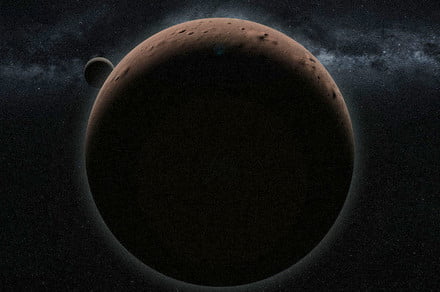2007 OR10, currently the largest unnamed world in our solar system.
It’s been 12 years since scientists at California’s Palomar Observatory discovered what is currently the largest unnamed world in our solar system.
Having gone with the default title (225088) 2007 OR10 since its discovery in 2007, the three scientists who identified the minor planet on the outer reaches of our solar system are now keen to give it an official name. And they want your help to do it.
In a recent article published by The Planetary Society, the scientists — Meg Schwamb, Mike Brown, and David Rabinowitz — revealed details of a public vote in which the most popular choice will be submitted to the International Astronomical Union (IAU) for consideration.
But in an effort to avoid the kind of absurdities that befell another online vote in 2016 when members of the public chose to call a British research vessel Boaty McBoatface, the scientists have sensibly come up with three options for voters to choose from. And no, “Planet McPlanetface” isn’t one of them.
The three choices fit IAU naming regulations and are associated with mythological creatures and figures that reflect aspects of 2007 OR10’s physical properties, which include rock, water ice, possibly methane ice, and a surface that’s red in color.
One of the candidate’s for the new name is Gonggong, described by the scientists as “a Chinese water god with red hair and a serpent-like tail. He is known for creating chaos, causing flooding, and tilting the Earth.”
Another option is Holle, “a European winter goddess of fertility, rebirth, and women. Holle makes snow by shaking out her bed. She is a patroness of household crafts especially spinning. She is linked to the Yuletide (winter solstice) season associated with mistletoe and holly, evergreen plants bearing red berries.”
Finally, there’s Vili, a Nordic deity, who, “together with his brothers Odin and Vé, defeated frost giant Ymir and used Ymir’s body to create the universe. Ymir’s flesh and bones were forged into the Earth, with Ymir’s blood becoming the rivers and oceans.”
2007 OR10, which is estimated to be just 775 miles (1,250 km) in diameter, was discovered during the Palomar Distant Solar System Survey that looked for objects of interest in the distant Kuiper belt and beyond. The survey used the 48-inch Samuel Oschin telescope at Palomar Observatory to conduct its search.
“This icy planetoid is the largest unnamed world in our solar system, but to me, it is the fuzzy blob that was moving across the images on my computer screen back in July 2007,” Schwamb wrote in the article, adding, “And now it needs a name.”
You have until May 10, 2019, to cast your vote.
Editors’ Recommendations
- Dwarf planet FarFarOut is the most distant object discovered in our solar system
- The Habitable Planet Finder is a new tool to locate Earth-like exoplanets
- Death of a planet: Astronomers discover grisly scene of planetary destruction
- Searching for habitable planets in the Goldilocks Zone of K stars
- NASA’s planet-hunting satellite TESS locates its first exoplanet

